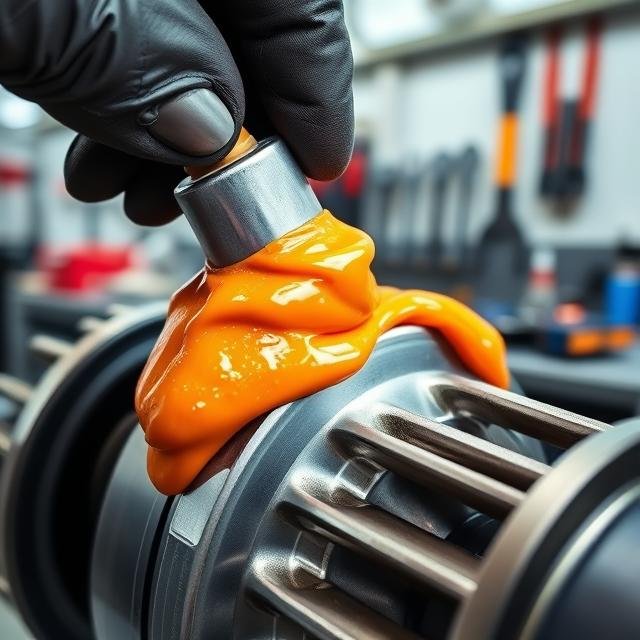In the vast and often unseen world of industrial manufacturing and material science, countless substances form the backbone of the products we use every day. While some, like steel or plastic, are household names, others operate in obscurity, known only to the engineers and technicians who rely on their unique properties. One such material is orange spline paste, a specialized compound whose vivid color and specific function make it an indispensable tool in precision assembly.
To understand orange spline paste, one must first break down its name. The “spline” refers to a key engineering feature: a ridge or tooth on a shaft that mates with a groove in a matching piece to transmit torque. Think of the splined shaft connecting your car’s gearbox to its wheels or the internal mechanisms of a heavy-duty power tool. These connections must be precise, strong, and durable. The “paste” is a viscous, high-performance lubricant and anti-seize compound. The “orange” is its most distinguishing visual characteristic—a bright, pigmented color that serves a critical purpose beyond mere branding.
Table of Contents
The Primary Function: Protection and Performance
Orange spline paste is not a generic lubricant. It is a meticulously formulated material designed for a specific class of problems encountered in mechanical engineering:
- Preventing Fretting Corrosion: This is its primary mission. When two metal surfaces under high load are subjected to minute microscopic movements (like the slight play in a splined coupling), they can undergo fretting corrosion. This wear process breaks down the protective oxide layer on the metal, leading to pitting, surface degradation, and ultimately, failure. The paste acts as a protective barrier, separating the metal surfaces and preventing this damaging contact.
- Inhibiting Corrosion and Seizing: Splined connections, especially in automotive, aerospace, and marine environments, are exposed to moisture, salt, and temperature extremes. These conditions can cause the mating parts to corrode and fuse together—a phenomenon known as “seizing” or “galling.” Disassembling seized components is often difficult, expensive, and can result in part destruction. Orange spline paste contains anti-corrosion and extreme pressure (EP) additives to ensure components can be disassembled even after years of service.
- Reducing Wear and Friction: While it is a high-tack paste (meaning it stays in place), it still provides lubrication during the initial assembly and any micro-movements. This reduces wear on the splines, extending the service life of expensive components like drive shafts, constant velocity (CV) joints, and propeller shafts.
- Providing a Visual Assembly Aid: The vibrant orange color is a functional trait. It provides technicians with a clear visual confirmation that the paste has been applied correctly and thoroughly. This is crucial for quality control in assembly lines and for mechanics ensuring a repair is done to specification. If you can see the orange hue evenly coating the splines, you know the protection is in place.
Key Components and Formulation
The exact formulation of orange spline paste varies by manufacturer, but it typically consists of a combination of the following:
- Base Oil: A high-viscosity mineral or synthetic oil that forms the fluid component of the paste.
- Thickener: Often a lithium-based or other complex soap, which gives the paste its semi-solid, sticky consistency, allowing it to adhere to vertical surfaces without dripping.
- Solid Lubricants: This is the secret weapon. Fine particles of molybdenum disulfide (Moly), graphite, or PTFE (Teflon) are suspended in the paste. These solids provide lubrication under extremely high pressure where liquid lubricants would fail.
- Anti-Corrosion Additives: Chemicals that protect the metal surfaces from oxidation and rust.
- Pigment: A thermally stable, non-reactive orange pigment that provides the distinctive color without compromising the paste’s performance.
Common Applications in the Real World
You won’t find a tube of orange spline paste at a typical hardware store. Its use is specialized and critical in several industries:
- Automotive and Trucking: The most common application is on the splines of CV joints and drive shafts in front-wheel and all-wheel-drive vehicles. During a rebuild or replacement, applying orange spline paste is a mandatory step to ensure longevity and prevent the tell-tale “clicking” sounds of a failing CV joint.
- Heavy Machinery: Construction equipment, agricultural tractors, and manufacturing machines use massive splined connections in their powertrains. The paste is essential for handling the immense torque loads.
- Aerospace and Marine: In these environments, corrosion resistance is paramount. The paste is used on propeller shafts, control linkages, and other critical components exposed to harsh elements.
- Power Tools and Industrial Equipment: The high-torque output of tools like impact wrenches and drills relies on robust internal splines that are protected with such pastes.
How to Use Orange Spline Paste Correctly
Using this material correctly is vital for its effectiveness. The general procedure is as follows:
- Safety First: Wear safety glasses and gloves. The paste is messy and can be difficult to wash off.
- Clean Surfaces: This is the most critical step. All mating parts must be thoroughly cleaned and degreased. Any dirt or old lubricant will compromise the new paste’s ability to adhere and protect.
- Apply Liberally and Evenly: Using a brush or applicator, apply a generous, even coat to all spline surfaces of both the male and female parts. The goal is complete coverage.
- Assemble: Mate the components together, twisting slightly to ensure the paste is distributed evenly throughout the connection.
- Torque to Spec: Secure any fasteners (like a hub nut) to the manufacturer’s specified torque setting.
- Clean Up: Wipe away any excess paste that has been extruded from the connection.
Conclusion
Orange spline paste is a perfect example of how a highly specialized material, though unknown to the general public, plays a vital role in the reliability and safety of the mechanical world. Its bright color is a beacon of precision engineering, signifying that a critical connection has been protected against the invisible threats of corrosion, wear, and seizure. The next time you see a vehicle on the road or hear the powerful hum of heavy machinery, you might just remember the small but crucial role played by that vivid orange paste, silently ensuring everything stays connected and functioning as intended.
Informational FAQs
Q1: Can I use a regular grease instead of orange spline paste?
A: It is strongly discouraged. Standard greases lack the extreme pressure additives and solid lubricants (like molybdenum disulfide) necessary to handle the high shear forces and prevent fretting corrosion on splines. Using the wrong lubricant can lead to premature wear and component failure.
Q2: Is the orange color just for show?
A: No, the color is functional. It serves as a visual indicator for technicians to confirm complete and even application during assembly or repair, which is a critical quality control step.
Q3: Is orange spline paste toxic?
A: While not highly toxic, it is a chemical product and should be handled with care. Always refer to the Safety Data Sheet (SDS) provided by the manufacturer. Avoid skin contact (use gloves) and avoid ingesting or inhaling it. Keep it away from children and pets.
Q4: Where can I buy orange spline paste?
A: It is typically sold through automotive parts suppliers (often behind the counter), industrial supply companies, and online retailers specializing in tools and mechanical supplies. Common brand names include Loctite, Wurth, and Permatex.
Q5: Does it ever need to be reapplied?
A: In theory, a properly applied paste during assembly should last the lifespan of the component. However, if the component is disassembled for any reason, the old paste must be completely cleaned off and a new, fresh application must be applied before reassembly.
Q6: What’s the difference between orange spline paste and anti-seize compound?
A: While both prevent seizing, anti-seize (often copper or nickel-based) is typically used on threaded fasteners and bolts and is designed for higher temperature applications. Spline paste is formulated specifically for the sliding, high-pressure, and fretting conditions found in splined couplings and often has different solid lubricants and a stickier consistency.

